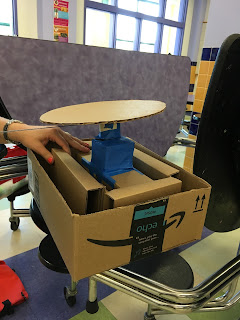In June, Somerville was fortunate to host Sallee Beneke, a leading expert on The Project Approach. We co-hosted this event with Tufts University and Charlestown Nursery School - partners who also know the value of inquiry based early childhood curriculum. Sallee's website, Illinois Projects in Practice, has both theory and practices related to project approach, as well as links to Early Childhood Research and Practice (see this great project about a car wash) which has great examples of projects.
As you begin to plan for the coming school year, think about what children will bring to your classroom. What will they want to learn about? What provocations or ideas do you have in mind that you think your children will want to study and expand upon? Are there current events, places of interest, in your community that children can directly experience that you would want to study?
During the workshop, teachers actually engaged in their own project based on their interests and so they experienced directly how rich the learning is when you follow children's interests as the project unfolds AND root children's learning in the community. This is important for young children and older children alike and is often referred to as Personalized Learning. Personalized learning opportunities offer children co-ownership of curriculum which leads to greater engagement in learning experiences. Teachers also learned about how this approach supports standards-based learning and addresses content across curriculum areas.
Before the workshop began, I scoped out the neighborhood in East Somerville near the Capuano Early Childhood Center where the workshop was held. Sallee has asked that we identify some local businesses and organizations where workshop participants could do "fieldwork" in the form of a visit to learn more and design a course of study. Making a trip to visit an expert on your topic or inviting an expert into your classroom is a key component of Project Approach.
- They visited.
- They conducted surveys and talked with customers and business owners.
- They brainstormed and webbed.
- They hypothesized
- They researched.
- They planned.
- They constructed something to represent their research.
But something even deeper happened. The teachers, upon visiting their sites, had powerful experiences in our community.
- They discovered a market they didn't know existed and saw that there were fresh fruits and vegetables for sale there, as well as ingredients for making dishes from Latin America. They got to know the owner and the customers.
- They visited a local laundromat and realized it was a place where people gather and wondered about how to connect with families who patronize it.
- They got to know the owner of a local cafe and learned how proud he is of both his heritage and beginnings in Portugal but also how deeply he cares about the local community in Somerville.
- They learned about a group of artists devoted to working in clay, how they connect with the community, understood more about the science and art of pottery.
- They discovered that the Beautiful Stuff Project, a local creative reuse center that many teachers regularly go to and get classroom supplies, functions as a non-profit and that its director searches far and wide to get the materials for teachers, families, and children in Somerville.
For their final experience, teachers created a documentation panel to tell the story of their learning. Creating these kinds of displays with children and including photographs, text, surveys, children's writing, etc. makes learning visible to children, families, colleagues, and administrators.
 |
| Sallee Beneke watches the teacher presentations. |
Projects are wonderful. They engage children in interesting topics and bring depth to a study beyond a weekly theme. But we learned about the power of connecting with people right here in our community. Dinosaurs are fascinating to children, but they can't touch them or interact with them. So as you begin to plan for this year's curriculum, consider engaging in a long-term project that connects children with the community they live in. You'll be glad you did!
Scroll down to see some of the components of the Project Approach that teachers practiced in June.
 |
| Teacher web of ideas for future study. This can also be done with children. |
 |
| Asking children to come up with questions about the topic helps guide the study. This is an example of what workshop participants wanted to know about Mudflat, a local clay studio. |
 |
| Questions generated about a local art studio and creative reuse center called The Beautiful Stuff Project. |
 |
| Teacher web about The Beautiful Stuff Project. |
 |
| Teacher web about the Ola Cafe. |
 |
| The Ola Cafe has a European-style juicer which teachers build as their representation of their project. |






No comments:
Post a Comment